Multi-modal version Llama2 is online, Meta releases AnyMAL
Refreshed the industry’s best zero-shot performance in multiple benchmark tests.
A unified model that can understand different modal input contents (text, image, video, audio, IMU motion sensor data) and generate text responses. The technology is based on Llama 2 , from Meta.
Yesterday, the research on the multi-modal large model AnyMAL attracted the attention of the AI research community.
Large Language Models (LLMs) are known for their enormous size and complexity, which greatly enhance the ability of machines to understand and express human language. Advances in LLMs have enabled significant advances in the field of visual language, bridging the gap between image encoders and LLMs, combining their inference capabilities. Previous multimodal LLM research has focused on models that combine text with another modality, such as text and image models, or on proprietary language models that are not open source.
If there is a better way to achieve multi-modal functionality and embed various modalities in LLM, will this bring us a different experience?
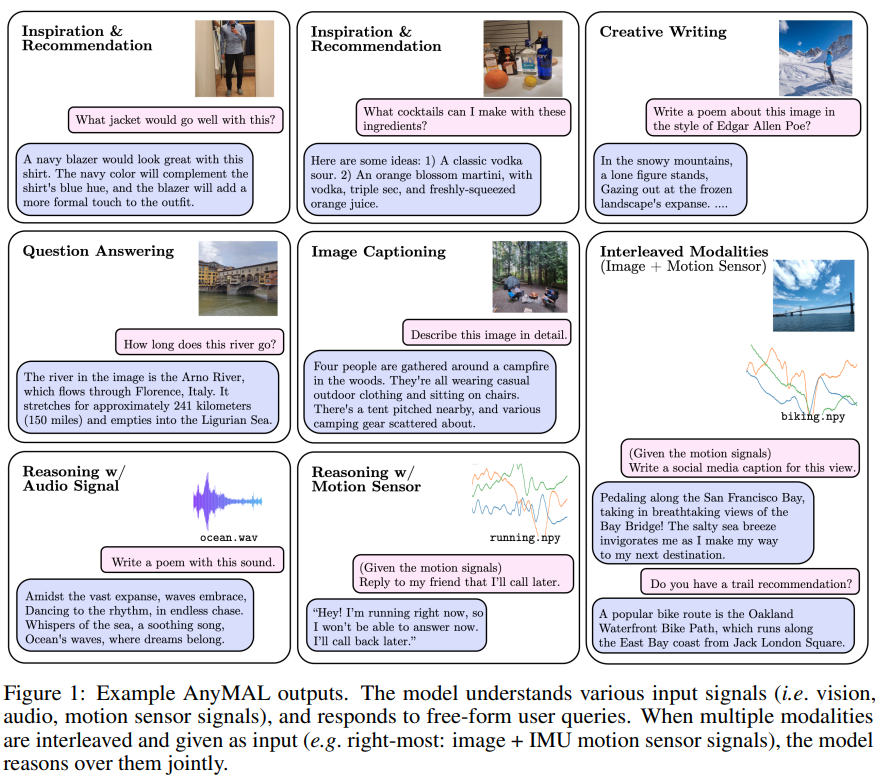
##Q output Example
This problem, researchers from META recently launched Anymal ( Any-Modality Augmented Language Model). This is a collection of multi-modal encoders trained to transform data from a variety of modalities, including images, video, audio, and IMU motion sensor data, into LLM’s text embedding space
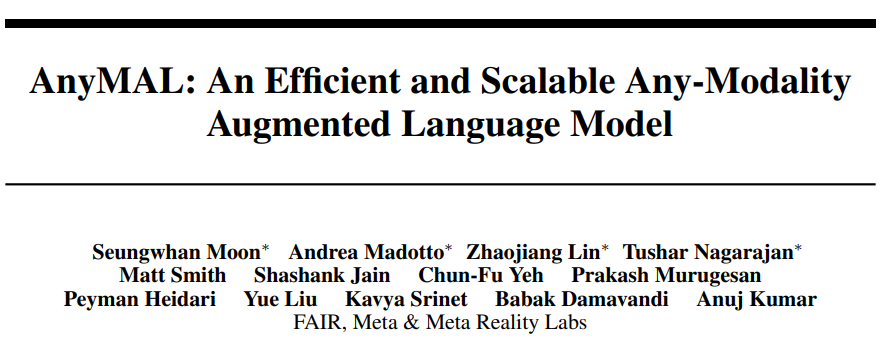
Paper address: https://huggingface.co/papers/2309.16058
According to the description, the main contributions of this research are as follows:
Proposed an efficient and scalable solution for building multi-modal LLM. This article provides projection layers pre-trained on large datasets containing multiple modalities (e.g., 200 million images, 2.2 million audio segments, 500,000 IMU time series, 28 million video segments), all All aligned to the same large model (LLaMA-2-70B-chat), enabling interleaved multi-modal contextual cues.
This study further fine-tuned the model using a multi-modal instruction set across three modalities (image, video and audio), covering various fields beyond simple question answering (QA). unlimited tasks. This dataset contains high-quality manually collected instruction data, so this study uses it as a benchmark for complex multi-modal reasoning tasks
The best model in this paper automatically performs various tasks and modes Compared with the models in the existing literature, the relative accuracy on VQAv2 has been improved by 7.0%, and the CIDEr on zero-error COCO image subtitles has been improved by 8.4%. Improved CIDEr by 14.5% on AudioCaps and created new SOTA
The content of pre-training modal alignment needs to be rewritten
By using paired multi-modal data (including specific modal signals and text narrative), this study pre-trained LLM to achieve multi-modal understanding capabilities, as shown in Figure 2. Specifically, we train a lightweight adapter for each modality that projects the input signal into the text token embedding space of a specific LLM. In this way, the text tag embedding space of LLM becomes a joint tag embedding space, where tags can represent text or other modalities. 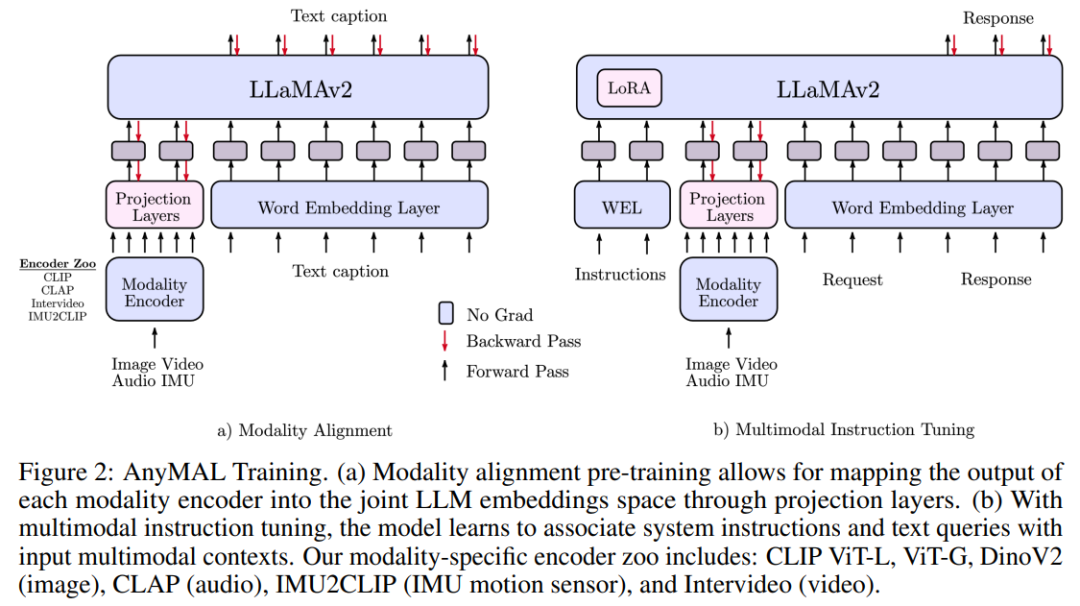 Regarding the study of image alignment, we used one of the LAION-2B dataset A clean subset was filtered using the CAT method to blur any detectable faces. For the study of audio alignment, the AudioSet (2.1M), AudioCaps (46K) and CLOTHO (5K) data sets were used. In addition, we also used the Ego4D dataset for IMU and text alignment (528K)For large datasets, scaling up pre-training to a 70B parameter model requires a lot of resources, often requiring the use of FSDP wrappers on multiple Slice the model on multiple GPUs. To effectively scale training, we implement a quantization strategy (4-bit and 8-bit) in a multi-modal setting, where the LLM part of the model is frozen and only the modal tokenizer is trainable. This approach reduces memory requirements by an order of magnitude. Therefore, 70B AnyMAL can complete training on a single 80GB VRAM GPU with a batch size of 4. Compared with FSDP, the quantization method proposed in this article only uses half of the GPU resources, but achieves the same throughput
Regarding the study of image alignment, we used one of the LAION-2B dataset A clean subset was filtered using the CAT method to blur any detectable faces. For the study of audio alignment, the AudioSet (2.1M), AudioCaps (46K) and CLOTHO (5K) data sets were used. In addition, we also used the Ego4D dataset for IMU and text alignment (528K)For large datasets, scaling up pre-training to a 70B parameter model requires a lot of resources, often requiring the use of FSDP wrappers on multiple Slice the model on multiple GPUs. To effectively scale training, we implement a quantization strategy (4-bit and 8-bit) in a multi-modal setting, where the LLM part of the model is frozen and only the modal tokenizer is trainable. This approach reduces memory requirements by an order of magnitude. Therefore, 70B AnyMAL can complete training on a single 80GB VRAM GPU with a batch size of 4. Compared with FSDP, the quantization method proposed in this article only uses half of the GPU resources, but achieves the same throughput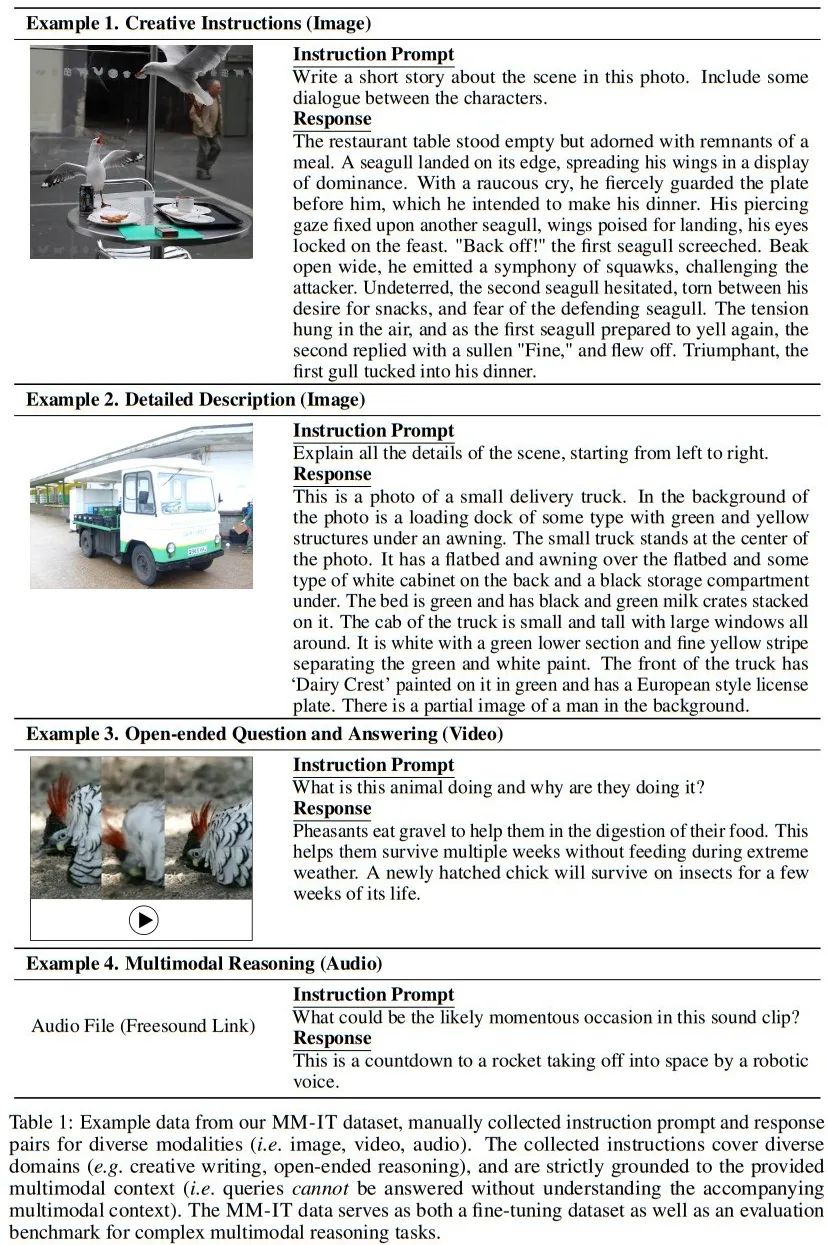
Using multi-modal instruction data sets for fine-tuning means using multi-modal instruction data sets for fine-tuning
In order to further To improve the model's ability to follow instructions for different input modalities, the study used the Multi-Modal Instruction Tuning (MM-IT) data set for additional fine-tuning. Specifically, we concatenate the input as [ ] so that the response target is based on both the textual instruction and the modal input. Research is conducted on the following two situations: (1) training the projection layer without changing the LLM parameters; or (2) using low-level adaptation (Low-Rank Adaptation) to further adjust the LM behavior. The study uses both manually collected instruction-tuned datasets and synthetic data.
] so that the response target is based on both the textual instruction and the modal input. Research is conducted on the following two situations: (1) training the projection layer without changing the LLM parameters; or (2) using low-level adaptation (Low-Rank Adaptation) to further adjust the LM behavior. The study uses both manually collected instruction-tuned datasets and synthetic data.
Experiments and results
Image title generation is an artificial intelligence technology used to automatically generate corresponding titles for images. This technology combines computer vision and natural language processing methods to generate descriptive captions related to the image by analyzing the content and characteristics of the image, as well as understanding the semantics and syntax. Image caption generation has wide applications in many fields, including image search, image annotation, image retrieval, etc. By automatically generating titles, the understandability of images and the accuracy of search engines can be improved, providing users with a better image retrieval and browsing experience. Description" Zero-shot image caption generation performance on a subset of the MM-IT dataset for the task (MM-IT-Cap). As can be seen, the AnyMAL variant performs significantly better than the baseline on both datasets. Notably, there is no significant gap in performance between the AnyMAL-13B and AnyMAL-70B variants. This result demonstrates that the underlying LLM capability for image caption generation is an artificial intelligence technique used to automatically generate corresponding captions for images. This technology combines computer vision and natural language processing methods to generate descriptive captions related to the image by analyzing the content and characteristics of the image, as well as understanding the semantics and syntax. Image caption generation has wide applications in many fields, including image search, image annotation, image retrieval, etc. By automating caption generation, image understandability and search engine accuracy can be improved, providing users with a better image retrieval and browsing experience. The task is less impactful, but depends heavily on data size and registration method. .
 The rewrite required is: Human evaluation on multi-modal inference tasks
The rewrite required is: Human evaluation on multi-modal inference tasks
Figure 3 shows that, compared with the baseline ( Compared with LLaVA: 34.4% winning rate and MiniGPT4: 27.0% winning rate), AnyMAL performs strongly and has a smaller gap with the actual manually labeled samples (41.1% winning rate). Notably, models fine-tuned with the full instruction set showed the highest priority winning rate, showing visual understanding and reasoning capabilities comparable to human-annotated responses. It is also worth noting that BLIP-2 and InstructBLIP perform poorly on these open queries (4.1% and 16.7% priority win rate, respectively), although they perform well on the public VQA benchmark (see Table 4) .
 VQA Benchmark
VQA Benchmark
In Table 4, we show the performance of the Hateful Meme dataset, VQAv2 , TextVQA, ScienceQA, VizWiz and OKVQA, and compared with zero-shot results on the respective benchmarks reported in the literature. Our research focuses on zero-shot evaluation to most accurately estimate model performance on open queries at inference time
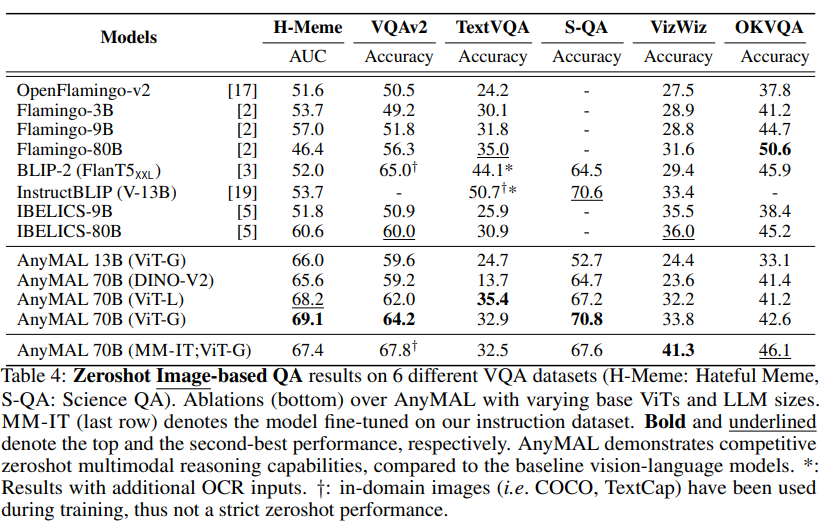 Video QA Benchmark
Video QA Benchmark
As shown in Table 6, the study evaluated the model on three challenging video QA benchmarks.
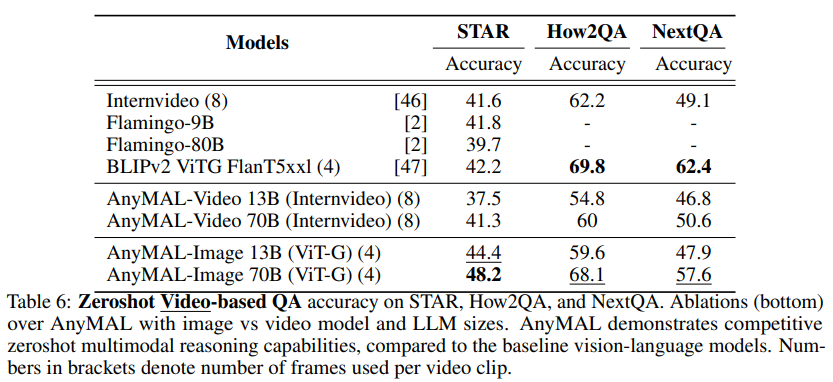 Regenerate audio subtitles
Regenerate audio subtitles
Table 5 shows the results of regenerating audio subtitles on the AudioCaps benchmark dataset. AnyMAL significantly outperforms other state-of-the-art audio subtitle models in the literature (e.g., CIDEr 10.9pp, SPICE 5.8pp), indicating that the proposed method is not only applicable to vision but also to various modalities. The text 70B model shows clear advantages compared to the 7B and 13B variants.
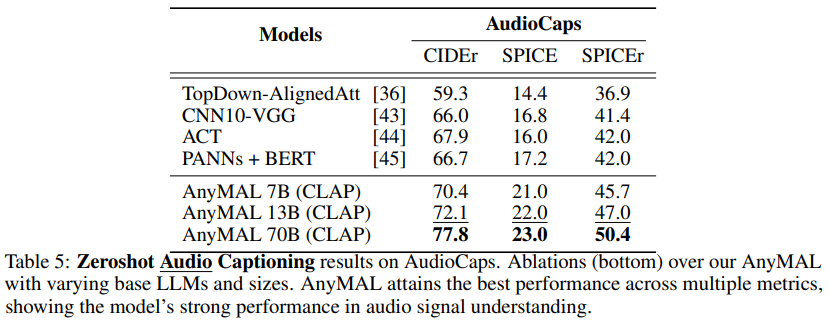
Interestingly, based on the method, type, and timing of the AnyMAL paper submission, Meta seems to be planning to collect multi-modal data through its newly launched mixed reality/metaverse headset. These research results may be integrated into Meta’s Metaverse product line, or may soon be used in consumer applications
Please read the original article for more details.
The above is the detailed content of Multi-modal version Llama2 is online, Meta releases AnyMAL. For more information, please follow other related articles on the PHP Chinese website!

Hot AI Tools

Undresser.AI Undress
AI-powered app for creating realistic nude photos

AI Clothes Remover
Online AI tool for removing clothes from photos.

Undress AI Tool
Undress images for free

Clothoff.io
AI clothes remover

AI Hentai Generator
Generate AI Hentai for free.

Hot Article

Hot Tools

Notepad++7.3.1
Easy-to-use and free code editor

SublimeText3 Chinese version
Chinese version, very easy to use

Zend Studio 13.0.1
Powerful PHP integrated development environment

Dreamweaver CS6
Visual web development tools

SublimeText3 Mac version
God-level code editing software (SublimeText3)

Hot Topics
 1376
1376
 52
52
 The author of ControlNet has another hit! The whole process of generating a painting from a picture, earning 1.4k stars in two days
Jul 17, 2024 am 01:56 AM
The author of ControlNet has another hit! The whole process of generating a painting from a picture, earning 1.4k stars in two days
Jul 17, 2024 am 01:56 AM
It is also a Tusheng video, but PaintsUndo has taken a different route. ControlNet author LvminZhang started to live again! This time I aim at the field of painting. The new project PaintsUndo has received 1.4kstar (still rising crazily) not long after it was launched. Project address: https://github.com/lllyasviel/Paints-UNDO Through this project, the user inputs a static image, and PaintsUndo can automatically help you generate a video of the entire painting process, from line draft to finished product. follow. During the drawing process, the line changes are amazing. The final video result is very similar to the original image: Let’s take a look at a complete drawing.
 New affordable Meta Quest 3S VR headset appears on FCC, suggesting imminent launch
Sep 04, 2024 am 06:51 AM
New affordable Meta Quest 3S VR headset appears on FCC, suggesting imminent launch
Sep 04, 2024 am 06:51 AM
The Meta Connect 2024event is set for September 25 to 26, and in this event, the company is expected to unveil a new affordable virtual reality headset. Rumored to be the Meta Quest 3S, the VR headset has seemingly appeared on FCC listing. This sugge
 Topping the list of open source AI software engineers, UIUC's agent-less solution easily solves SWE-bench real programming problems
Jul 17, 2024 pm 10:02 PM
Topping the list of open source AI software engineers, UIUC's agent-less solution easily solves SWE-bench real programming problems
Jul 17, 2024 pm 10:02 PM
The AIxiv column is a column where this site publishes academic and technical content. In the past few years, the AIxiv column of this site has received more than 2,000 reports, covering top laboratories from major universities and companies around the world, effectively promoting academic exchanges and dissemination. If you have excellent work that you want to share, please feel free to contribute or contact us for reporting. Submission email: liyazhou@jiqizhixin.com; zhaoyunfeng@jiqizhixin.com The authors of this paper are all from the team of teacher Zhang Lingming at the University of Illinois at Urbana-Champaign (UIUC), including: Steven Code repair; Deng Yinlin, fourth-year doctoral student, researcher
 Posthumous work of the OpenAI Super Alignment Team: Two large models play a game, and the output becomes more understandable
Jul 19, 2024 am 01:29 AM
Posthumous work of the OpenAI Super Alignment Team: Two large models play a game, and the output becomes more understandable
Jul 19, 2024 am 01:29 AM
If the answer given by the AI model is incomprehensible at all, would you dare to use it? As machine learning systems are used in more important areas, it becomes increasingly important to demonstrate why we can trust their output, and when not to trust them. One possible way to gain trust in the output of a complex system is to require the system to produce an interpretation of its output that is readable to a human or another trusted system, that is, fully understandable to the point that any possible errors can be found. For example, to build trust in the judicial system, we require courts to provide clear and readable written opinions that explain and support their decisions. For large language models, we can also adopt a similar approach. However, when taking this approach, ensure that the language model generates
 The first open source model to surpass GPT4o level! Llama 3.1 leaked: 405 billion parameters, download links and model cards are available
Jul 23, 2024 pm 08:51 PM
The first open source model to surpass GPT4o level! Llama 3.1 leaked: 405 billion parameters, download links and model cards are available
Jul 23, 2024 pm 08:51 PM
Get your GPU ready! Llama3.1 finally appeared, but the source is not Meta official. Today, the leaked news of the new Llama large model went viral on Reddit. In addition to the basic model, it also includes benchmark results of 8B, 70B and the maximum parameter of 405B. The figure below shows the comparison results of each version of Llama3.1 with OpenAIGPT-4o and Llama38B/70B. It can be seen that even the 70B version exceeds GPT-4o on multiple benchmarks. Image source: https://x.com/mattshumer_/status/1815444612414087294 Obviously, version 3.1 of 8B and 70
 Axiomatic training allows LLM to learn causal reasoning: the 67 million parameter model is comparable to the trillion parameter level GPT-4
Jul 17, 2024 am 10:14 AM
Axiomatic training allows LLM to learn causal reasoning: the 67 million parameter model is comparable to the trillion parameter level GPT-4
Jul 17, 2024 am 10:14 AM
Show the causal chain to LLM and it learns the axioms. AI is already helping mathematicians and scientists conduct research. For example, the famous mathematician Terence Tao has repeatedly shared his research and exploration experience with the help of AI tools such as GPT. For AI to compete in these fields, strong and reliable causal reasoning capabilities are essential. The research to be introduced in this article found that a Transformer model trained on the demonstration of the causal transitivity axiom on small graphs can generalize to the transitive axiom on large graphs. In other words, if the Transformer learns to perform simple causal reasoning, it may be used for more complex causal reasoning. The axiomatic training framework proposed by the team is a new paradigm for learning causal reasoning based on passive data, with only demonstrations
 arXiv papers can be posted as 'barrage', Stanford alphaXiv discussion platform is online, LeCun likes it
Aug 01, 2024 pm 05:18 PM
arXiv papers can be posted as 'barrage', Stanford alphaXiv discussion platform is online, LeCun likes it
Aug 01, 2024 pm 05:18 PM
cheers! What is it like when a paper discussion is down to words? Recently, students at Stanford University created alphaXiv, an open discussion forum for arXiv papers that allows questions and comments to be posted directly on any arXiv paper. Website link: https://alphaxiv.org/ In fact, there is no need to visit this website specifically. Just change arXiv in any URL to alphaXiv to directly open the corresponding paper on the alphaXiv forum: you can accurately locate the paragraphs in the paper, Sentence: In the discussion area on the right, users can post questions to ask the author about the ideas and details of the paper. For example, they can also comment on the content of the paper, such as: "Given to
 A significant breakthrough in the Riemann Hypothesis! Tao Zhexuan strongly recommends new papers from MIT and Oxford, and the 37-year-old Fields Medal winner participated
Aug 05, 2024 pm 03:32 PM
A significant breakthrough in the Riemann Hypothesis! Tao Zhexuan strongly recommends new papers from MIT and Oxford, and the 37-year-old Fields Medal winner participated
Aug 05, 2024 pm 03:32 PM
Recently, the Riemann Hypothesis, known as one of the seven major problems of the millennium, has achieved a new breakthrough. The Riemann Hypothesis is a very important unsolved problem in mathematics, related to the precise properties of the distribution of prime numbers (primes are those numbers that are only divisible by 1 and themselves, and they play a fundamental role in number theory). In today's mathematical literature, there are more than a thousand mathematical propositions based on the establishment of the Riemann Hypothesis (or its generalized form). In other words, once the Riemann Hypothesis and its generalized form are proven, these more than a thousand propositions will be established as theorems, which will have a profound impact on the field of mathematics; and if the Riemann Hypothesis is proven wrong, then among these propositions part of it will also lose its effectiveness. New breakthrough comes from MIT mathematics professor Larry Guth and Oxford University




